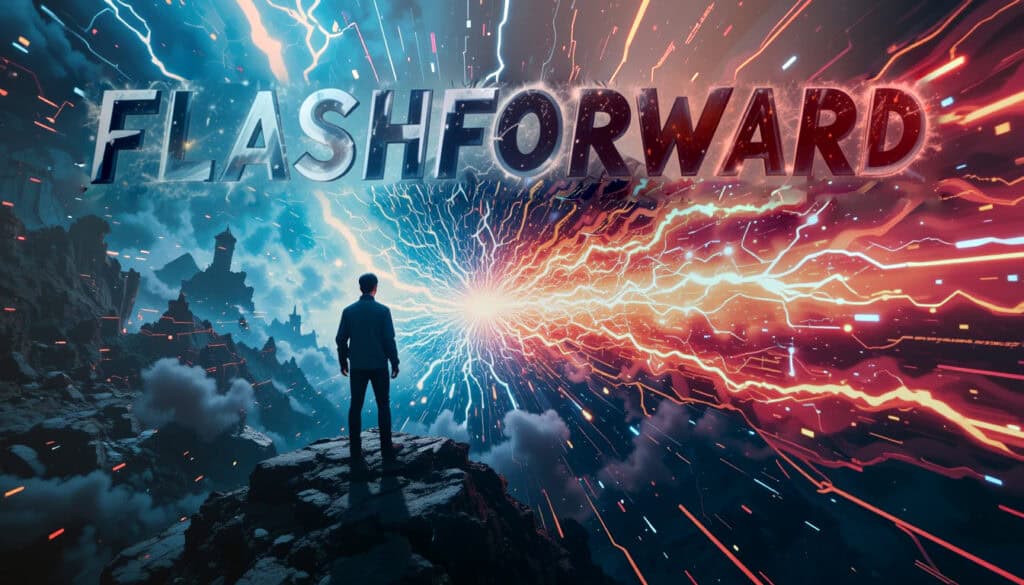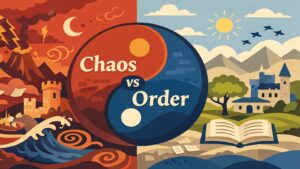Table of Contents
Introduction: How Flashforward Turns Outcome into Mystery
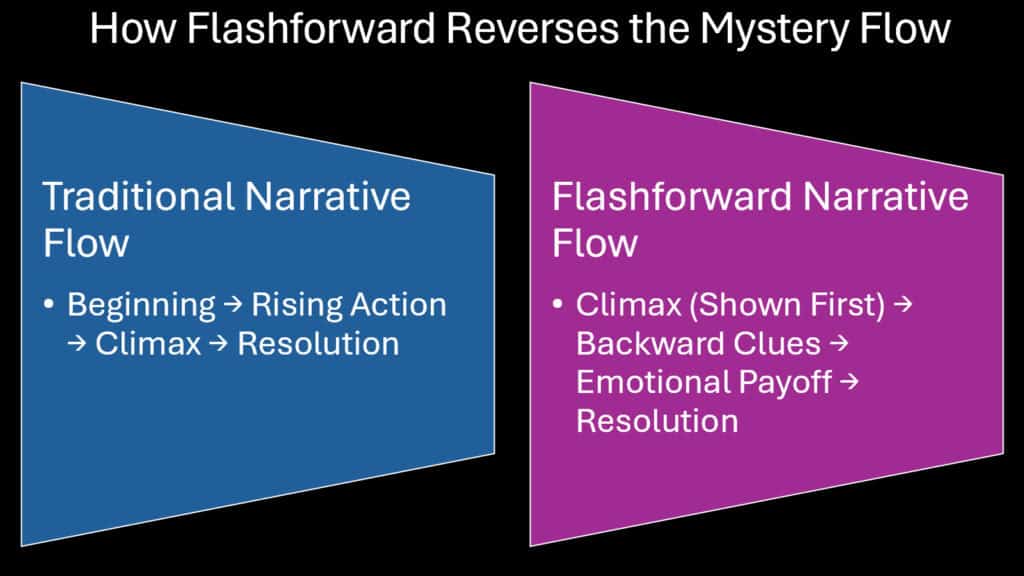
Every great story whispers a secret before it speaks the truth. When Gabriel García Márquez opened One Hundred Years of Solitude with the line about José Arcadio Buendía facing a firing squad while remembering ice, he revealed an ending that became a beginning. This moment captures the essence of flashforward, one of literature’s most powerful and widely used storytelling techniques that transforms conventional narrative wisdom on its head.
Flashforward challenges our basic understanding of suspense. While traditional storytelling builds tension through uncertainty about what will happen next, flashforward creates mystery by showing us exactly what will happen, then daring us to discover how we arrive at that inevitable moment. This narrative technique appears across cultures and continents, from the opening scenes of Gabriel García Márquez’s magical realism to the temporal complexities of Japanese author Haruki Murakami’s surreal landscapes.
The technique operates on a fundamental paradox. By revealing the destination, flashforward transforms the journey into the mystery. When we know that Walter White will become a dangerous criminal in Breaking Bad, the question shifts from what he will become to how he transforms from mild-mannered chemistry teacher to ruthless drug lord. When we learn in This Is Us that Jack Pearson will die, our focus moves from whether he survives to understanding the profound impact his life and death have on his family’s future.
This article explores six distinct ways flashforward builds mystery by working backward through time. We examine how this technique creates narrative gaps that demand exploration, how it reframes ordinary moments as significant waypoints, and how it transforms readers from passive observers into active detectives piecing together the puzzle of causation.
Table 1: Global Literary Works Using Flashforward Techniques
| Work | Author/Creator | Origin | Flashforward Element |
|---|---|---|---|
| One Hundred Years of Solitude | Gabriel García Márquez | Colombia | Opening execution scene |
| The God of Small Things | Arundhati Roy | India | Sophie Mol’s death revealed early |
| Slaughterhouse-Five | Kurt Vonnegut | United States | Billy’s time-unstuck experiences |
| The Handmaid’s Tale | Margaret Atwood | Canada | Historical notes epilogue |
| Cloud Atlas | David Mitchell | United Kingdom | Nested narrative structure |
1. Flashforward and the Mystery of Unknown Journey
Flashforward creates mystery through strategic revelation and concealment. The technique shows us the destination while carefully hiding the path, transforming what appears to be a spoiler into the opening statement of a complex puzzle. This approach directly connects to Roland Barthes’ concept of the hermeneutic code, which identifies how narratives create and sustain enigmas that drive reader engagement.
According to Barthes’ framework, the hermeneutic code operates through a series of narrative elements that pose questions, delay answers, and ultimately provide resolution. Flashforward manipulates this code by appearing to provide immediate resolution while actually deepening the central enigma. When we see the flash-forward scene, we possess knowledge of what will happen, but this knowledge creates new questions rather than answering existing ones.
Consider Arundhati Roy’s The God of Small Things, which reveals Sophie Mol’s death in the opening chapters. This revelation doesn’t diminish suspense but redirects it. The mystery transforms from whether Sophie Mol will die to understanding the complex web of family relationships, social prejudices, and childhood innocence that leads to this tragedy. Each scene becomes weighted with significance as readers search for clues about causation rather than outcome.
The hermeneutic code explains why Flashforward works so effectively across different cultures and storytelling traditions. In Chinese author Mo Yan’s Red Sorghum, the narrator reveals the fate of his grandparents early in the novel, then spends the remainder exploring the violent beauty of their lives during wartime. The mystery lies not in their survival but in understanding how love and brutality intertwine in their story.
Japanese filmmaker Akira Kurosawa employed similar techniques in Ikiru, revealing that the protagonist Kanji Watanabe will die of cancer, then exploring how this knowledge transforms his understanding of life’s meaning. The flashforward creates space for philosophical exploration rather than plot-driven suspense.
Table 2: Barthes’ Hermeneutic Code Elements in Flashforward Narratives
| Code Element | Traditional Function | Flashforward Function |
|---|---|---|
| Enigma | Poses central question | Reveals outcome, poses causation question |
| Snare | False or partial answer | Apparent resolution creates deeper mystery |
| Equivocation | Deliberate ambiguity | Clear future event, ambiguous path |
| Jamming | Acknowledgment of insolubility | Recognition that knowing ending isn’t knowing story |
| Disclosure | Final revelation | Continuous revelation of how rather than what |
2. Flashforward as a Story Map, Not a Spoiler
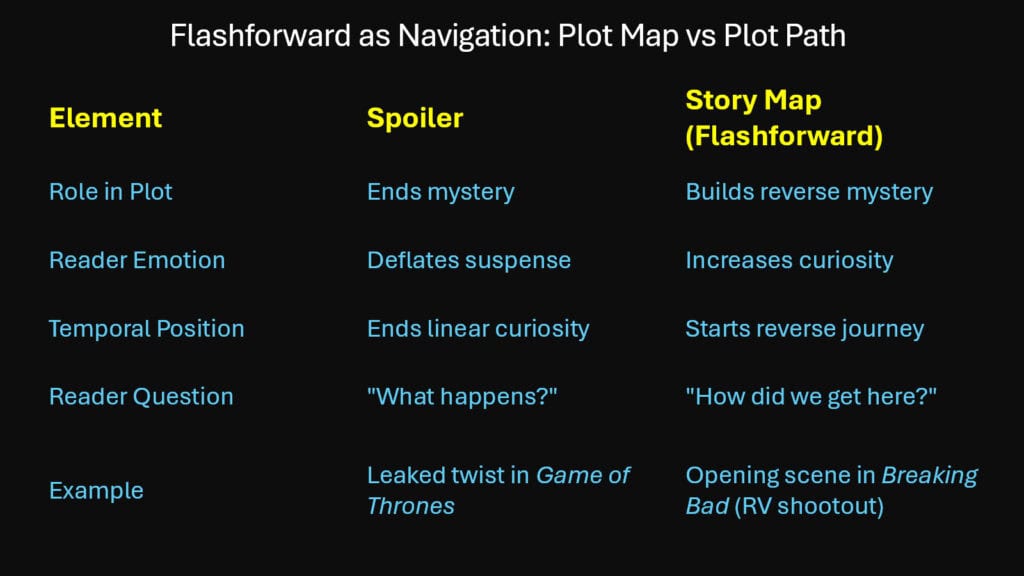
The most sophisticated uses of flashforward transform revealed intion into narrative roadmaps that enhance rather than diminish the reading experience. When executed skillfully, flashforward provides orientation rather than revelation, guiding readers through complex emotional and thematic territory while preserving the essential mystery of human transformation.
Breaking Bad demonstrates this principle masterfully through its opening sequences that show Walter White in compromised situations before explaining how he arrived there. The pilot episode opens with Walter driving an RV in his underwear, a gun in his hand, sirens approaching. This scene doesn’t spoil the story but establishes the trajectory of Walt’s moral descent while leaving viewers to discover the specific steps of his transformation.
Similarly, This Is Us uses flashforward to create emotional roadmaps rather than plot spoilers. When viewers learn that Jack Pearson dies in a house fire, this knowledge doesn’t diminish the show’s impact but reframes every scene of family happiness as precious and temporary. The flashforward transforms ordinary family moments into profound meditations on love, loss, and the fragility of human connection.
This technique appears in literature across cultures with remarkable consistency. In Isabel Allende’s The House of the Spirits, the opening line reveals Clara’s death while she predicts her own demise, establishing the novel’s magical realist tone while providing a framework for understanding the cyclical nature of the del Valle family’s story. The flashforward serves as a compass pointing toward themes of fate, family, and political upheaval.
African author Chinua Achebe uses similar techniques in Things Fall Apart, where early references to Okonkwo’s fate establish the tragic arc while allowing readers to understand the complex cultural forces that drive his downfall. The revealed destination helps readers navigate the novel’s exploration of colonialism’s impact on traditional Igbo society.
Table 3: Flashforward as Narrative Navigation Tool
| Function | Traditional Spoiler | Flashforward Map |
|---|---|---|
| Information Purpose | Reveals plot resolution | Provides thematic orientation |
| Reader Engagement | Reduces suspense | Redirects attention to causation |
| Emotional Effect | Diminishes impact | Intensifies emotional investment |
| Story Structure | Linear revelation | Layered understanding |
| Character Development | Outcome-focused | Process-focused |
3. Flashforward and the Mystery of Shifting Meaning
Flashforward transforms readers into active interpreters who must constantly revise their understanding of events as new information emerges. This process directly engages Reader-Response Theory, which emphasizes how readers actively construct meaning rather than passively receiving it from the text. Wolfgang Iser’s concept of “gaps” in narrative becomes particularly relevant, as flashforward creates intentional spaces that readers must fill through interpretation and reinterpretation.
Reader-Response Theory suggests that meaning emerges from the interaction between text and reader, with each reading potentially producing different interpretations. Flashforward amplifies this process by forcing readers to hold multiple possible meanings simultaneously. A simple conversation between characters gains new significance when readers know future outcomes, creating layers of dramatic irony that must be navigated and understood.
Margaret Atwood’s The Handmaid’s Tale exemplifies this technique through its epilogue, which reveals that Offred’s story is being studied by future historians. This flash-forward reframes the entire narrative, transforming Offred’s personal testimony into historical document while raising questions about reliability, interpretation, and the nature of truth itself. Every scene requires reexamination through this new lens.
In Haruki Murakami’s Hard-Boiled Wonderland and the End of the World, flashforward elements create parallel realities that readers must navigate simultaneously. The technique forces active engagement as readers construct connections between different temporal states and reality levels. Each revealed future element transforms past scenes into new puzzles requiring fresh interpretation.
The mystery of shifting meaning appears across global literature. In Milan Kundera’s The Unbearable Lightness of Being, philosophical reflections on eternal return create flashforward-like effects that reframe the characters’ choices and relationships. Readers must constantly revise their understanding of events as new philosophical contexts emerge.
Table 4: Reader-Response Theory Elements in Flashforward Narratives
| Theory Component | Reader Role | Flashforward Effect |
|---|---|---|
| Active Construction | Creates meaning through reading | Reconstructs meaning through revealed futures |
| Gap-Filling | Interprets textual spaces | Bridges temporal gaps between present and future |
| Horizon of Expectations | Brings prior knowledge to text | Adjusts expectations based on revealed outcomes |
| Implied Reader | Responds to textual cues | Becomes detective solving causation mysteries |
| Aesthetic Response | Experiences emotional and intellectual engagement | Experiences heightened dramatic irony |
4. Flashforward as Emotional Mystery: Knowing, But Dreading
Flashforward creates unique emotional landscapes where knowledge becomes a source of tension rather than relief. This phenomenon generates what might be called “emotional mystery,” where readers understand what will happen but experience profound anxiety about the journey toward that inevitable moment. The technique transforms anticipation into a complex emotional experience that combines dread, hope, and the bittersweet recognition of impermanence.
Atonement by Ian McEwan demonstrates this emotional complexity through its structure, which reveals the truth about Robbie’s fate while exploring the psychological aftermath of false accusations and war. Readers know early that Robbie dies in the war, but this knowledge intensifies rather than diminishes the emotional impact of his scenes with Cecilia. Every moment of happiness becomes precious because readers understand its temporary nature.
The emotional mystery extends beyond individual character fates to encompass broader narrative themes of loss, transformation, and the passage of time. In This Is Us, knowing that Jack Pearson will die in a house fire creates an emotional framework where every family scene carries weight. The flashforward doesn’t eliminate surprise but redirects emotional energy toward appreciation and dread, creating a viewing experience that is simultaneously heartwarming and heartbreaking.
International literature employs similar emotional strategies. In José Saramago’s Blindness, the gradual revelation of society’s collapse creates emotional mystery where readers understand the destination while dreading each step of social breakdown. The technique transforms a dystopian narrative into an emotional journey that explores human dignity under extreme circumstances.
Toni Morrison’s Beloved uses flashforward elements to create emotional mystery around the trauma of slavery. The revelation of Sethe’s infanticide early in the novel doesn’t diminish its impact but creates space for exploring the psychological and spiritual aftermath of such desperate choices. The emotional mystery lies in understanding how people survive and find meaning after experiencing unthinkable trauma.
Table 5: Emotional Mystery Elements in Flashforward Narratives
| Emotional Component | Traditional Suspense | Flashforward Mystery |
|---|---|---|
| Primary Emotion | Uncertainty about outcome | Dread of known outcome |
| Temporal Focus | Future-oriented anxiety | Present-moment appreciation |
| Character Investment | Hope for survival/success | Understanding of inevitable loss |
| Emotional Intensity | Builds toward climax | Sustained throughout narrative |
| Resolution | Relief or disappointment | Acceptance and understanding |
5. Flashforward and Temporal Disjunction: Breaking Linear Time
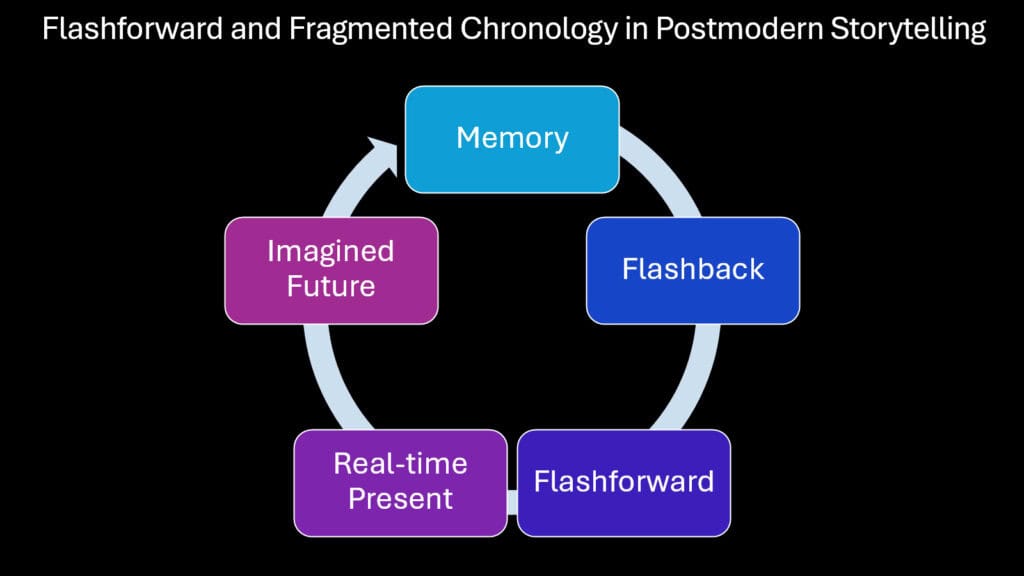
Flashforward disrupts conventional narrative time, creating what postmodern narrative theory describes as temporal disjunction. This technique mirrors how human consciousness actually experiences time, particularly in moments of traumatic flashbacks, chaotic memories, and intense emotion. Rather than following strict chronological order, flashforward reflects the way memory folds back on itself, creating connections across temporal boundaries that linear storytelling cannot achieve.
Postmodern narrative theory, particularly as developed by theorists like Jean-François Lyotard and Fredric Jameson, examines how contemporary storytelling reflects the fragmented nature of modern experience. Flashforward illustrates this fragmentation by disrupting the cause-and-effect relationships that characterize conventional narrative structure. Events become interconnected through thematic and emotional resonance rather than simple chronological sequence.
Kurt Vonnegut’s Slaughterhouse-Five exemplifies temporal disjunction through Billy Pilgrim’s experience of becoming “unstuck in time.” The novel’s structure mirrors trauma’s impact on consciousness, where past, present, and future collapse into simultaneous experience. The flashforward elements don’t create traditional suspense but explore how traumatic events reshape temporal perception and memory.
This technique appears across cultures in works dealing with trauma, displacement, and cultural transition. In Maxine Hong Kingston’s The Woman Warrior, flashforward elements connect Chinese legends with contemporary Chinese-American experience, creating temporal bridges that span generations and cultures. The technique allows exploration of how ancestral stories inform present identity.
Latin American literature has particularly embraced temporal disjunction through magical realism. In Laura Esquivel’s Like Water for Chocolate, recipes and cooking instructions create flashforward-like effects that connect past cooking experiences with future emotional states. The technique transforms linear storytelling into cyclical, ritualistic narrative that reflects Mexican cultural relationships with time and memory.
Table 6: Temporal Disjunction Elements in Postmodern Narratives
| Temporal Element | Linear Narrative | Disjunctive Flashforward |
|---|---|---|
| Time Structure | Sequential progression | Folded, layered time |
| Causation | Clear cause-effect | Multiple simultaneous causations |
| Memory Function | Background information | Active narrative force |
| Trauma Representation | Past event affecting present | Past, present, future collapsed |
| Cultural Time | Universal linear progression | Culture-specific temporal concepts |
6. Flashforward as a Moral Mirror: Who the Character Becomes
Flashforward often reveals character transformation, creating moral mystery where readers must trace the journey from innocence to corruption, weakness to strength, or ignorance to wisdom. This technique transforms character development into detective work, where readers piece together the psychological and moral steps that lead to profound personal change.
Better Call Saul demonstrates this moral archaeology through its exploration of Jimmy McGill’s transformation into the criminal lawyer Saul Goodman. The series uses flashforward to show glimpses of Jimmy’s future as Gene, a sad figure working in a Cinnabon, hiding from his criminal past. This revelation creates moral mystery around the question of whether Jimmy’s transformation represents inevitable character flaws or unfortunate circumstances.
The Godfather Part II employs similar techniques by contrasting young Vito Corleone’s rise with Michael Corleone’s moral descent. The parallel timelines create flashforward-like effects that illuminate how similar circumstances can produce vastly different moral outcomes. The method investigates themes of fate, decision-making, and the repetitive cycle of aggression.
Literature across cultures uses flash-forward to examine moral transformation. In Charles Dickens’ A Christmas Carol, the Ghost of Christmas Yet to Come shows Scrooge his future death and the indifferent reaction it provokes. This flashforward creates moral mystery by revealing the destination while leaving the path to redemption open for exploration.
Nigerian author Chimamanda Ngozi Adichie uses similar techniques in Half of a Yellow Sun, where flash-forward elements reveal the impact of the Biafran War while exploring how ordinary people navigate extraordinary moral challenges. The technique examines how political upheaval forces individuals to discover aspects of themselves they never knew existed.
Table 7: Moral Transformation Through Flashforward
| Transformation Type | Initial State | Revealed Future | Moral Mystery |
|---|---|---|---|
| Corruption | Innocent/Naive | Morally compromised | What breaks moral resistance? |
| Redemption | Flawed/Selfish | Heroic | What inspires moral growth? |
| Disillusionment | Idealistic | Cynical/Realistic | What destroys faith? |
| Awakening | Unconscious | Aware/Activated | What triggers consciousness? |
| Sacrifice | Self-centered | Self-sacrificing | What motivates ultimate giving? |
Conclusion: Flashforward and the Mystery That Follows the End
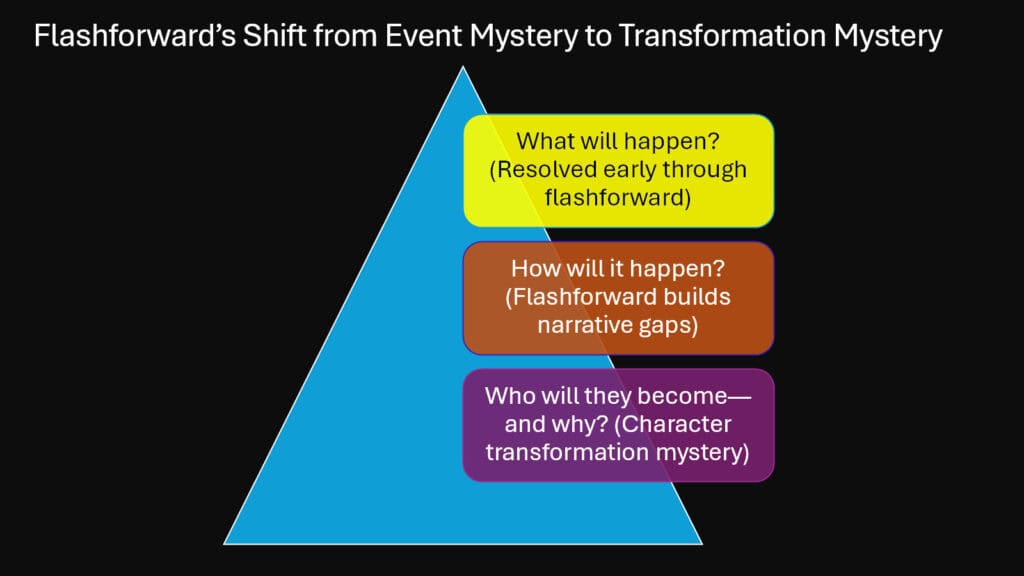
Flashforward represents one of storytelling’s most sophisticated techniques for creating mystery through revelation rather than concealment. By showing us endings at the beginning, flashforward transforms our entire relationship with narrative time and causation. The technique doesn’t eliminate suspense but redirects it, creating new forms of engagement that require active interpretation and emotional investment.
The six ways flashforward builds mystery in reverse demonstrate the technique’s versatility across cultures and genres. From creating narrative gaps that demand exploration to transforming ordinary moments into significant waypoints, flashforward proves that knowing the destination often makes the journey more compelling rather than less. The technique succeeds because it mirrors how human consciousness actually works, connecting past, present, and future through emotional and thematic resonance rather than simple chronological sequence.
Modern storytelling increasingly embraces non-linear narrative structures that reflect our fragmented, interconnected world. Flashforward offers writers and filmmakers a tool for exploring complex themes of fate, choice, memory, and transformation. The technique acknowledges that life’s most important questions aren’t about what will happen but about how and why things happen as they do.
The global embrace of flash-forward techniques suggests something fundamental about human nature and storytelling. We are drawn to narratives that challenge our assumptions about time, causation, and meaning. Flashforward satisfies this desire by creating puzzles that require both intellectual and emotional engagement. The mystery follows the end because the end is never really the end, but simply another beginning in our ongoing attempt to understand the complex relationships between choice, consequence, and meaning.
Table 8: Flashforward’s Impact on Contemporary Storytelling
| Narrative Element | Traditional Approach | Flashforward Innovation |
|---|---|---|
| Suspense Creation | Unknown outcomes | Known outcomes, unknown causation |
| Reader Engagement | Passive consumption | Active interpretation |
| Temporal Structure | Linear progression | Layered, interconnected time |
| Character Development | Progressive revelation | Reverse archaeology |
| Thematic Exploration | Forward-building | Backward-revealing |
| Emotional Impact | Climactic resolution | Sustained complexity |
The mystery that follows the end reminds us that every ending contains the seeds of new beginnings, and every answer generates fresh questions worth exploring.

